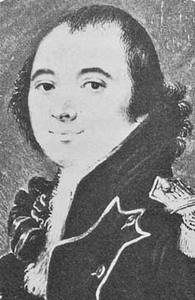General François Joseph Kirgener

Born: October 8, 1766
Place of Birth: Paris, Paris, France
Died: May 22, 1813
Cause of Death: Killed in action
Place of Death: Bautzen, Germany
Arc de Triomphe: KIRGENER on the east pillar
Pronunciation:
A professor of mathematics before the French Revolution, François Joseph Kirgener entered the École des Ponts et Chaussées in June of 1793. About six weeks later he was commissioned as a lieutenant of engineers. Placed with the Army of the North, he was promoted to capitaine in November but then arrested in December. After being transported to Arras, he was released in late April of 1794. Rejoining the army, Kirgener served at the combat of Grand Reng, the crossing of the Sambre, and the siege of Charleroi. Next he joined the Army of the Sambre and Meuse and he took part in the sieges of Landrecies, Quesnoy, and Maestricht. In October of 1794 Kirgener joined the Army of the Coasts of Brest and then that December he was promoted to chef de bataillon. The following July he served at Quiberon where his right arm was broken by a shot. Authorized to return to Paris to recover, he studied courses at the École Polytechnique during this downtime. After recovering, Kirgener was next sent to Antwerp in March of 1796 and then in August he was sent to Landau. In September he joined the Army of Ireland but the expedition to Ireland failed to land the troops. In March of 1797 Kirgener rejoined the Army of the Sambre and Meuse and then the next month he served during the crossing of the Rhine and subsequent battle at Neuwied. Next he took part in the blockade of Ehrenbreistein and he was then stationed at Besançon.
In July of 1798 Kirgener was designated to take part in the second expedition to Ireland under General Hardy as the commander of engineers. That September he embarked on the vessel Hoche but he was taken prisoner during the naval combat of October 12th against the British. Kirgener was released on parole in December and then in May he returned to Besançon as the chief engineer there. Kirgener was next employed in the Army of the Reserve in March of 1800. After marching over the Alps, he was ordered to attack Fort Bard and he went on to serve at Montebello and Marengo. After a brief stint at Milan, Kirgener then returned to Besançon and he was promoted to chef de brigade.
After a few years of relative peace, in 1805 the Grande Armée marched to war and Kirgener took command of the engineers of Marshal Lannes' V Corps. During the campaign of 1805 he contributed to the crossings of the Rhine and the Danube and he served at Linz, Saint-Poelten, Hollabrunn, and finally Austerlitz. In recognition of his services he was promoted to général de brigade on Christmas Day of 1805. In 1806 Kirgener returned to the army in September and then in October he assumed command of the park of engineers. He served at Jena and Golymin in 1806 and then at Eylau in 1807. Next he took part in the siege of Graudenz and then he became deputy commander of engineers and later chief of staff of engineers at the Siege of Danzig . Rewards followed as Kirgener became a Commander of the Legion of Honor in 1807 and in 1808 he became an inspector of engineers and a Baron of the Empire.
General Kirgener was next sent to Spain where he served in VII Corps under Gouvion St. Cyr. He took part in the fighting at Cardedeu, Molins del Rey, and Valls before heading to Germany and Austria to join the army there for the Danube campaign. On June 1st, 1809 he took command of the engineers of the Imperial Guard. That August he was allowed to go on leave and on September 30th he married Mademoiselle Guéhéneuc, the daughter of a senator. This marriage made him a brother-in-law to Marshal Lannes' widow and Colonel Guéhéneuc, an aide to Napoleon. Kirgener had little time to rest though for in November he was sent to the Army of the North to command the engineers against the British forces on the isle of Walcheren.
In the following years Kirgener was employed in the Netherlands to strengthen defenses at Helder and the isle of Texel. In 1812 he joined the Grande Armée on the Russian campaign and in March of 1813 he was promoted to général de division. Taking part in the campaign in Saxony that spring, Kirgener was with Napoleon, Caulaincourt, and Duroc at Bautzen when they rode through some smoke drifting over the battlefield. A cannonball flew by and struck a tree, then bounced and instantly killed Kirgener before ricocheting off him and mortally wounding General Duroc.1
Notes
Bibliography
External Links:
Updated March 2023
© Nathan D. Jensen